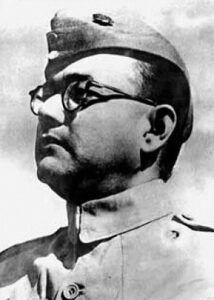Subhas Chandra Bose- The leftist Congressman

- Subhas Chandra Bose was born on 23 January 1897 (at 12.10 pm) in Cuttack, Orissa Division, Bengal Province, to Prabhavati Dutt Bose and Janakinath Bose, an advocate belonging to a Kayastha family. He was the ninth in a family of 14 children. His family was well to do.
- He was influenced by the teachings of Swami Vivekananda and Ramakrishna after reading their works at the age of 16. He felt that his religion was more important than his studies.
- In those days, the British in Calcutta often made offensive remarks to the Indians in public places and insulted them openly. This behaviour of the British as well as the outbreak of World War I began to influence his thinking.
- He got fourth in the Indian Civil Services examination, but resigned from ICS in 1921 as he don’t want to work for the opponents of Indians.
Writing to his brother Sarat Chandra Bose He said: ” Only on the soil of sacrifice and suffering can we raise our national edifice.”
- He started the newspaper Swaraj and took charge of publicity for the Bengal Provincial Congress Committee.
- He became the president of all India Youth Congress and also the secretary of Bengal State Congress.
- In 1927, after being released from prison, Bose became general secretary of the Congress party and worked with Jawaharlal Nehru for independence. In late December 1928, Bose organised the Annual Meeting of the Indian National Congress in Calcutta. His most memorable role was as General Officer Commanding (GOC) Congress Volunteer Corps.
- Bose emerged as the mayor of Calcutta in 1930.
- He also researched and wrote the first part of his book The Indian Struggle, which covered the country’s independence movement in the years 1920–1934. Although it was published in London in 1935, the British government banned the book in the colony out of fears that it would encourage unrest.
- By 1938 Bose had become a leader of national stature and agreed to accept nomination as Congress President.
- He stood for unqualified Swaraj (self-governance), including the use of force against the British. This meant a confrontation with Mohandas Gandhi, who in fact opposed Bose’s presidency, splitting the Indian National Congress party.
All India Forward Bloc was a left-wing nationalist political party in India which emerged as a faction within the India Congress in 1939, led by Subhas Chandra Bose. He was well known for his leftist views in the Congress. The prime objective of the Froward Bloc was to bring all radical elements of the Congress party. So that he could spread the meaning of complete independence of India with adherence of the application of principles of equality and social justice
An important development in the struggle for freedom during the Second World War was the formation and activities of the Azad Hind Fauj, also known as the Indian National Army, or INA. Rash Behari Bose, an Indian revolutionary who had escaped from India and had been living in Japan for many years, set up the Indian independence league with the support of Indians living in the countries of south-east Asia.
When Japan defeated the British armies and occupied almost all the countries of south-East Asia, the league formed the Indian National Army from among the Indian prisoners of war with the aim of liberating India from the British rule. General Mohan Singh, who had been an officer in the British Indian army, played an important role in organizing this army.
In the meantime, Subhas Chandra Bose had escaped from India in 1941 and gone to Germany to work for India’s Independence. In 1943, he came to Singapore to lead the Indian Independence league and rebuild the Indian National Army (Azad Hind Fauj) to make it an effective instrument for the freedom of India. The Azad Hind Fauj comprised of about 45,000 soldiers, among who were Indian prisoners of war as well as Indians who were settled in various countries of south-east Asia.
Indian women also played an important role in the activities for the freedom of India. A women’s regiment of Azad Hind Fauj was formed, which was under the command of Captain Lakshmi Swaminathan. It was called the Rani Jhansi regiment. The Azad Hind Fauj became the symbol of unity and heroism to the people of India. Netaji, who had been one of the greatest leaders of India’s struggle for freedom, was reported killed in an air crash a few days after Japan had surrendered.
Read more about freedom fighter Dr. B R Ambedkar~ The Father of Indian Constitution.

